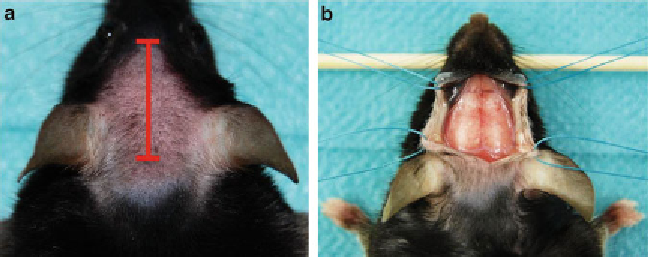Biology Reference
In-Depth Information
Fig. 4. (
a
) Illustrates the level of the 2-cm linear scalp incision. (
b
) Shows exposition of the fronto-parieto-occipital scull
after four-point retraction and suture fi xation. The shaft of a cotton swab is placed under the front incisors for horizontal
alignment of the scull.
four-point scalp fi xation with four silk sutures (6/0) (Fig.
4b
).
The sutures should be attached to the portable pad. The shaft of a
cotton swab is placed under the front incisors for perpendicular
alignment of the LASCA device and the scull during the measure-
ment. Two to three drops of paraffi n oil should be applied on the
exposed surface to prevent drying of the scull during the ongoing
LASCA measurement.
To prevent hypothermia during prolonged measurement periods,
a heating pad is recommended. The animal is positioned under the
LASCA device with a distance of 30 cm between the cortical sur-
face/scull and the Laser/CCD Camera. The orientation of the
Laser/CCD camera is set perpendicular to the targeted surface and
the system is turned on. After selection of ROIs and gain adjust-
ment, the live image measurements and plotted CBF-fl ux are dis-
played on the personal computer in real time and stored on a hard
drive for off-line evaluation. After the measurement is completed,
the mouse is returned to the surgical work area. The surgical fi eld
is irrigated, thoroughly disinfected, and the wound is sutured with
6/0 nylon in conventional fashion.
2.3.3. Laser Speckle
Imaging
The tissue preparation gets more demanding after repeated open-
ing and suturing for consecutive measurements in the same animal.
The formation of scar tissue infl uences the LASCA measurement
in two ways:
1. The limited lateral retraction of the scalp hampers an adequate
exposure.
2. The tissue obstructs the imaging fi eld either directly or indi-
rectly through diffuse bleeding after dissection.
Pitfalls
The scalp is best mobilized by gentile retraction and scissor/
microscissor dissection superfi cial to the fascia of the temporal
muscle. This ensures good mobilization for far lateral retraction

Search WWH ::

Custom Search